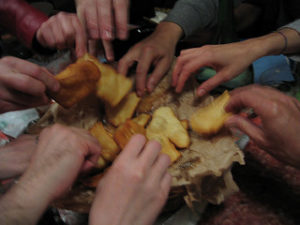 This is part of a series, introduced in Baby Steps, about arts organizations’ initial efforts in community engagement. For details about the premises upon which these posts are based, see below. The essence is that simple, inexpensive initial steps offer the best way to embark upon community engagement.
This is part of a series, introduced in Baby Steps, about arts organizations’ initial efforts in community engagement. For details about the premises upon which these posts are based, see below. The essence is that simple, inexpensive initial steps offer the best way to embark upon community engagement.
Share What You Have: Connecting as Community Citizens
Beyond what was discussed in Be What You Are, a means of connecting with communities that does not have an impact upon programming is the of sharing organizational resources–physical, human, and infrastructural. In the context of community engagement, the point is to provide benefit to communities as a means of developing trust and supporting relationship building. Think of it as lending a neighbor a cup of sugar. And to be clear, this does not suggest anything that would have a significant impact on the budget or staff.
Awareness of community needs and interests can help inform how this might look. Some organizations that have their own facilities provide community groups with meeting space. After Hurricane Sandy, a theatre company in Manhattan put a generator on the street outside their offices so people could charge their cell phones. It took awareness of the need and the company’s self-identification as a member of the community to inspire that action.
An interesting idea proposed by museum director, community engagement advocate, and writer Nina Simon is the use of an arts organization’s presenting platforms to build relationships. In The Future of Authority: Platform Power she suggested “that museums could give up control of the visitor experience while still maintaining (a new kind of) power. Museums could make the platforms for those experiences. There is power IN the platform–power to shape the way people participate.” In other words, presenting forums could be made available to communities. Whether community organized pop-up exhibitions in the museum or performances of community cultural resources, the organization’s platform could be a significant tool for substantive engagement.
Another type of resource sharing is the joint fundraiser or cause-related marketing of tickets. I have always had trouble with people describing fundraisers or ticket sales where a portion goes to a charitable organization (cause-related marketing) as community engagement. True engagement requires more mutuality and more of a two-way relationship than such practices usually involve. However, fundraisers and ticket sales are an infrastructural platform that arts organizations possess and sharing revenue from either is a valid way to provide something of benefit to a community organization. To be clear, these things cannot be looked on as the culmination of any community engagement effort. However, they can be an element of a larger process of relationship building.
These are just a few of the possibilities for connecting with communities that can be imagined when an organization identifies itself as a community member willing and able to contribute to the life of the community and, thereby, to develop relationships within it.
Engage!
Doug
Photo: ![]()
![]()
![]() Some rights reserved by Marco40134
Some rights reserved by Marco40134
The premises of this blog series are twofold. First, since relationship building is the core of community engagement, attempting to do too much too fast (before the relationship is established) will likely not be productive and, in fact, may be counter-productive. Second, there are many things that can be done to support engagement that do not require new personnel or new budgets. Simply re-imagining (and perhaps slightly re-tooling) things that are already being done can support engagement in very effective ways.
It should go without saying that the core of all engagement work is a strong (even if not unanimous) desire on the part of the organization to make connections with new communities. If the will to do so is lacking, the work will be at best minimally successful.
